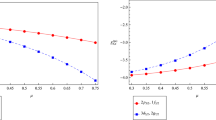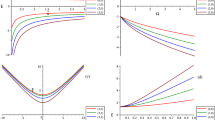Abstract
We study the nonrelativistic Schrödinger wave equation under the influence of a quantum flux field with an interaction potential in the background of a pointlike global monopole (PGM). In fact, we consider an inverse quadratic Yukawa plus inverse square potential and derive the radial equation employing the Greene–Aldrich approximation scheme in the centrifugal term. We determine the approximate eigenvalue solution using the parametric Nikiforov–Uvarov method and analyze the result. Afterwards, we derive the radial wave equation using the same potential employing a power series expansion method in the exponential potential and solve it analytically. We show that the energy eigenvalues are shifted by the topological defects of a pointlike global monopole as compared to the flat space result. In addition, we see that the energy eigenvalues depend on the quantum flux field that shows an analogue to the Aharonov–Bohm effect.




Similar content being viewed by others
References
S. M. Ikhdair and R. Sever, J. Molec. Struct.: THEOCHEM 855, 13 (2008).
S. M. Ikhdair, Cent. Eur. J. Phys. 10, 361 (2012).
S. M. Ikhdair and M. Hamzavi, Few-Body Syst. 53, 487 (2012).
C. Berkdemir, J. Math. Chem. 46, 139 (2009).
C. Berkdemir and Y. F. Cheng, Phys. Scr. 79, 034003 (2009).
S. M. Ikhdair and R. Sever, Int. J. Mod. Phys. C 19, 221 (2008).
S. M. Ikhdair and R. Sever, Int. J. Mod. Phys. A 21, 6699 (2006).
S. M. Ikhdair and R. Sever, Int. J. Mod. Phys. A 21, 3989 (2006).
H. Hassanabadi, H. Rahimov, and S. Zarrinkamar, Adv. High Energy Phys. 2011, 458087 (2011).
S. H. Dong, Int. J. Quant. Chem. 109, 701 (2009).
B. J. Falaye, Few-Body Syst. 53, 557 (2012).
W. Greiner and B. Muller, Quantum Mechanics: An Introduction (Springer, Berlin, Germany, 1994).
L. D. Landau and E. M. Lifshitz, Quantum Mechanics, the Non-relativistic Theory (Pergamon, Oxford, 1977).
H. Haken and H. C. Wolf, Molecular Physics and Elements of Quantum Chemistry: Introduction to Experiments and Theory (Springer, Berlin, Germany, 1995).
F. Constantinescu and E. Magyari, Probelms in Quantum Mechanics (Pergamon Press, Oxford, 1971).
D. J. Griffiths, Introduction to Quantum Mechanics (Prentice-Hall, New-Jersey, 2004).
C. Furtado and F. Moraes, J. Phys. A: Math. Gen. 33, 5513 (2000).
R. L. L. Vitoria and H. Belich, Phys. Scr. 94, 125301 (2019).
A. L. C. de Oliveira and E. R. B. de Mello, Int. J. Mod. Phys. A 18, 3175 (2003).
E. R. B. de Mello and C. Furtado, Phys. Rev. D 56, 1345 (1997).
A. L. Cavalcanti de Oliveira and E. R. B. de Mello, Int. J. Mod. Phys. A 18, 2051 (2003).
A. L. Cavalcanti de Oliveira and E R Bezerra de Mello, Class. Quantum Grav. 23, 5249 (2006).
Geusa de A. Marques and Valdir B. Bezerra, Class. Quantum Gravit. 19, 985 (2002).
P. Nwabuzor, C. Edet, A. N. Ikot, U. Okorie, M. Ramantswana, R. Horchani, A. H. A.-Aty, and G. Rampho, Entropy 23(8), 1060 (2021).
F. Ahmed, Mol. Phys. 120, e2124935 (2022).
F. Ahmed, arXiv: 2209.13490 [quant-ph].
F. Ahmed, arXiv: 2210.04617 [hep-th].
F. Ahmed, Phys. Scr. 98, 015403 (2023).
F. Ahmed, EPL 141, 25003 (2003).
F. Ahmed, Mol. Phys. 121, e2155596 (2023).
F. Ahmed, Int. J. Geom. Meths. Mod. Phys. 20, 2350060 (2023).
F. Ahmed, Indian J. Phys. (2023). https://doi.org/10.1007/s12648-023-02590-6.
W. C. F. da Silva and K. Bakke, Eur. Phys. J. C 79, 559 (2019).
W. C. F. da Silva, K. Bakke and R. L. L. Vitoria, Eur. Phys. J. C 79, 657 (2019).
A. Boumali and H. Aounallah, Adv. High Energy Phys. 2018, 1031763 (2018).
M. Hamzavi, S. M. Ikhdair, and B. I. Ita, Phys. Scr. 85, 045009 (2012).
C. A. Onate, Afr. Rev. Phys. 8, 0046 (2013).
B. I. Ita and A. I. Ikeuba, J. Atomic Mol. Phys. 2013, 582610 (2013).
R. L. Greene and C. Aldrich, Phys. Rev. A 14, 2363 (1976).
M. R. Setare and S. Haidari, Phys. Scr. 18, 065201 (2010)
W. C. Qiang, K. Li, and W. L. Chen, J. Phys. A: Math. Theor. 42, 205306 (2009).
A. F. Nikiforov and V. B. Uvarov, Special Functions of Mathematical Physics (Birkhauser, Basel, 1988).
M. de Montigny, H. Hassanabadi, J. Pinfold, and S. Zare, Eur. Phys. J. Plus 136, 788 (2021).
M. de Montigny, J. Pinfold, S. Zare and H. Hassanabadi, Eur. Phys. J. Plus 137, 54 (2022).
Y. Aharonov and D. Bohm, Phys. Rev. 115, 485 (1959).
M. Peshkin and A. Tonomura, The Aharonov–Bohm Effect (Lecture Notes Phys. Vol. 340, Springer, Berlin, Germany, 1989).
M. Abramowitz and I. Stegun, Handbook of Mathematical Functions (Vol. 52, Dover, New York, 1965).
L. J. Slater, Confluent Hypergeometric Functions (Cambridge University Press, Cambridge, 1960).
Author information
Authors and Affiliations
Corresponding author
Ethics declarations
The author declares that he has no conflicts of interest.
Appendix
Appendix
1.1 THE NIKIFOROV–UVAROV (NU) PARAMETRIC METHOD
The Nikiforov–Uvarov method is a helpful technique to calculate exact and approximate energy eigenvalues and wave functions of Schrödinger-like equations and other second-order differential equations of physical interest. According to this method, the wave functions of a second-order differential equation [42]
are given by
and that the energy eigenvalue equation holds,
The parameters \(\alpha_{4},\ldots,\alpha_{13}\) are obatined from the six parameters \(\alpha_{1},\ldots,\alpha_{3}\) and \(\xi_{1},\ldots,\xi_{3}\) as follows:
In a special case where \(\alpha_{3}=0\), we find
and
Therefore the wave function from (A.2) becomes
where \(L^{(\beta)}_{n}(x)\) denotes the generalized Laguerre polynomial.
The energy eigenvalues equation reduces to
Rights and permissions
About this article
Cite this article
Ahmed, F. Topological Effects with Inverse Quadratic Yukawa Plus Inverse Square Potential on Eigenvalue Solutions. Gravit. Cosmol. 29, 232–239 (2023). https://doi.org/10.1134/S0202289323030039
Received:
Revised:
Accepted:
Published:
Issue Date:
DOI: https://doi.org/10.1134/S0202289323030039




